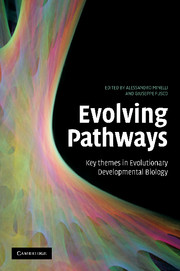Part III - Evolving diversity
Published online by Cambridge University Press: 08 August 2009
Summary
Are there clades whose particular origin or evolutionary history are more adequately explained when considering the possibilities offered by changes at the level of developmental processes, instead of thinking in terms of the unceasing interplay between gene mutation and natural selection? Yes, this is exactly the field where evo-devo offers its best performances. These are stories rooted deep in time, where one must also consider the possibility that in due course even the ‘rules of the game’, such as the role of Hox genes, or more generally the genotype–phenotype relationships, have evolved along with their products. Or, they may be stories where adaptive explanations are unsatisfactory, and the course of evolution can appear to be driven more by the nature of variation that is produced at each generation than by adaptive necessities.
Jaume Baguñà, Pere Martinez, Jordi Paps and Marta Riutort (Chapter 12) address the problem of early bilaterian evolution. Their work is based on the most recent molecular phylogenies and on new data on Hox/ParaHox and microRNA sets that identify acoelomorphs as the earliest branching extant bilaterians. Evidence for axial homologies in gene expression between cnidarians and bilaterians and the evidence that cnidarians were at their origin bilaterally symmetric all point to an older last common ancestor for bilaterians. Thus, what under different phylogenetic hypotheses appear to be a number of phylogenetically coincident character changes (the complex Urbilateria hypothesis) turn into a series of nodes connected by stem ancestors along which new characters were progressively acquired.
- Type
- Chapter
- Information
- Evolving PathwaysKey Themes in Evolutionary Developmental Biology, pp. 215 - 216Publisher: Cambridge University PressPrint publication year: 2008
- 1
- Cited by



